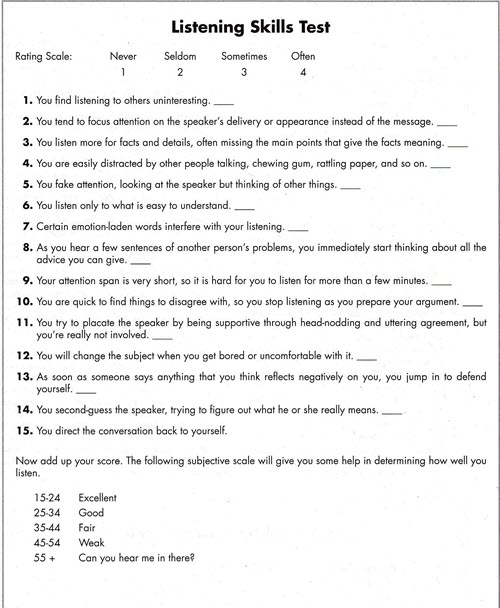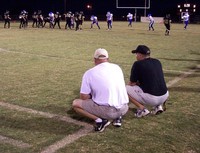Continuing our Psychological Skills Training series in pelinks4u, Part II of Communication (See October 2015 for Part I) is written to assist coaches in improving their skills or can be used as an in-service with a group of coaches.

Attentive Listening
Listening skills are critical for good communication. It is important to assess listening skills prior to helping athletes and coaches build more effective methods of listening. The “Listening Skills Test” will be completed by each athlete and coach. Then the athlete or coach will request input on his or her listening behaviors from a friend or family member.
Activity: Evaluating Your Listening Skills
- Do “Listening Skills Test.”
- Ask those that know you to share their perceptions of your listening skills.

Improving Your Listening Skills
Once the “Listening Skills Test” and the feedback from friend/family member have been discussed, athletes and coaches will be introduced to empathetic and active listening.
Empathetic Listening
– Understanding a person from his/her frame of reference.
– Attend – listen – to content, body language, feelings
Active Listening
– Stop what you are doing and give full attention to other person
– Use encouragement- simple affirmations (“I see”, “uh-huh” with nod of head)
– Paraphrase content and reflect feelings (“It sounds like you’re excited about _______”)
– Ask questions for clarification and elaboration that are open-ended- can’t be answered with “yes”, “no” or another single word (“That’s interesting- would you tell me more about it” or “What happened next” or “What would you do differently next time”). Also, avoid questions that start with the word “why”, which can evoke defensive responses.
– Check your perceptions. “Let me make sure I understand” or “Just to clarify, did you say _________?”
– Convey interest nonverbally. Open posture, lean forward, make eye contact, be relaxed, can use head tilt or raised eyebrow. Males- some research supports side-to-side vs. facing as more effective.
– Practice this. Next time you’re talking with a person about a problem or personal issue, restate the meaning of their message before stating your opinion. When talking to an athlete, have him/her summarize what you just said.
– Giving athletes advice on personal or school problems. Use active listening to allow athlete to express emotion. When done venting and athlete becomes more logical and task focused, ask questions and don’t be quick to give advice.

Conflicts and Confrontations
Communicating in situations where there is conflict and confrontation is difficult at best. Since individuals’ responses are not the same at that point, it is important for athletes and coaches to have an awareness of their goals and their relationship with the other person, and, to understand the various ways an individual might react in the midst of conflict/confrontation.
Five Conflict-Management Styles
Based on how you answer two questions in an attempt to resolve a conflict:
- How important is it that you achieve your personal goals and get what you want?
- How important is your relationship with the other person?
Evaluating Your Listening Skills
- Turtle (withdrawing)
- Fear confrontation or believe it will be useless in solving the problem
- Sacrifice goals and damage relationships
- Shark (attacking)
- Try to get own way no matter what the cost
- Don’t worry about needs and feelings of others
- Play to win by intimidating, attacking and overpowering
- Teddy Bear (Smoothing)
- Avoid conflicts in favor of harmony
- Sacrifice personal goals to avoid conflict because they need to be accepted and liked
- Good at keeping a team together at expense of own needs and interests
- Fox (Compromising)
- Want to achieve goals and maintain relationships to a degree
- Will give up part of their goal and try to persuade others to do the same
- Will accept strain on relationship to find agreement for the common good
- Owl (Collaborating)
- Highly value their goals and relationships
- View conflict as an issue to be solved and are satisfied only when they and others are able to achieve their goals.
- Believe conflict can strengthen relationships and will work to resolve tension and negative feelings (win-win).
Activity:
In a conflict situation the goal (win, compromise, find 3rd alternative.) and relationship (continue relationship, don’t need to have contact in the future.) may vary. Thus, different styles may be used by the same person. For instance, when competing, an athlete or coach may be a “shark” with the opponent but a “fox” with a teammate.
List two conflict situations where you used a different style for each:
Situation #1: Style used:
Situation #2 Style used:
Remember the 2 initial questions when selecting a conflict-management style.
- How important is it that you achieve your personal goals and get what you want?
- How important is your relationship with the other person?
- Successful coaches focus both on meeting goals and on maintaining relationships.
- You may have one or two dominant styles, but need to be skilled in using all styles.
Confrontations
- To resolve conflicts you directly express your views and feelings about the conflict and invite the other parties to do the same in order to negotiate a mutually beneficial solution.
- Use confrontation when it is necessary to solve a problem. Confront in a way that does not create arguments and feelings of hostility.
- Tone Matching: we tend to match the tone that is directed at us. Be aware of your tone!
- How to Confront: be assertive- stand up for your rights without attacking or degrading others. Four guidelines:
- Think before you speak. Assess your own emotions and the emotions of others. Sometimes it is wise to wait.
- Seek to understand the other person’s perspective. Use empathy.
- Describe your perspective and feelings using “I” statements.
- Seek action. Tentatively communicate what you’d like to see happen (vs. demand). Discuss the issue (keeps person from feeling attacked, getting defensive and rebelling).
Model for preparing for a confrontation:
The best hope for success when confronting someone is to take time to prepare. The following model is recommended.
Step 1: I care… Tell the person you are concerned and care about him/her. Expression of concern can be difficult, but it is vital.
Step 2: I see… Share your list of behaviors that concern you with the person. What have you seen? What did s/he do or say? What have you heard? It is important that this be done in an objective, non-judgmental manner. Stress behaviors.
Step 3: I feel… Tell the person how you feel. “I’m worried.angry.afraid.concerned” Stress your feelings.
Step 4: Listen. A variety of responses can be expected. Many will say nothing, as they are not ready to talk. Some may become angry and tell you it’s none of your business. They may point out that others are doing this too. Defensiveness is very common. Stick to your agenda. Others may share with you a problem that is beyond your ability to help. By listening carefully, you will be able to move on to steps 5 and 6.
Step 5: I want… State your expectations clearly. “I want you to go and talk to the trainer.” I want you to come on time for practice”.
Step 6: I will… Tell the person what you are willing to do to help him/her to meet your expectations. This can include being there to listen, finding needed resources or helping to arrange a meeting with a counselor. If the person chooses to say/do nothing let him/her know the door is open in the future to discuss the issue again, or, you will be meeting with the person again on ______.
Here is a real world example of the model:

PARENTS, COACH, PRINCIPAL & SCHOOL BOARD
We recently had a student athlete disciplined for drinking. She is a great kid from a caring family. She was suspended and told she could not participate in 20% of the games during the upcoming season. The parents understood the consequences. However, a problem arose over the wording in the student handbook about which contests she would not be allowed to participate in. The handbook does not specify if she has to miss the first two games or the ninth and tenth games, etc. The parents are taking their argument to the school board and are attempting to determine which contests their daughter should miss. The parents are making this a big deal and it is taking a lot of my time. – High School Coach
List behaviors you have observed. Make your list as specific and concrete as possible.
- Parents came to me to talk about the games their daughter would miss.
- When I showed them the handbook the parents didn’t agree it had to be the first two games and then went to talk to the principal.
- When the principal also said it would be the first two games the parents went to talk to the School Board President who then put it on the agenda for a school board meeting.
Step 1: I care… I care about your daughter. She is a great person and a valued athlete. I appreciate both of you. You’ve been so supportive of me and the team.
Step 2: I see…
- You came to me to talk about the games your daughter wouldn’t be able to participate in.
- When I said it would be the first two games, you went to talk to the principal about the wording in the handbook.
- When the principal said it would be the first two games you went to talk to the School Board President and asked to talk to the School Board about this.
- Since we last met, I’ve been called in to talk to the Principal and Board President.
Step 3: I feel…I feel frustrated and angry.
Step 4: Listen.
Step 5: I want… I want you to respect my decision about your daughter sitting out the first two games. I want you to not go to the School Board about my decision.
Step 6: I will… I will continue to coach your daughter fairly and will play her according to her ability once her suspension is over.
References
Much of the material for this session is taken from:
Sport Psychology for Coaches (2008) by Damon Burton & Thomas Raedeke, Human Kinetics, Champaign, IL. The “Model for preparing for a confrontation” was proposed by Harriet Marritz, Gettysburg College, Gettysburg, PA. The “Parents, Coach, Principal and School Board” scenario recently occurred at a PA High School.

hello my name is Leonardo Simões, I am a Master’s student in Sports and I am doing a project where I will use the listening skills test and needed the source of origin and the author of the test
Dear Leonardo, The Listening Skills test is found on page 27 of the book Sport Psychology for Coaches by Damon Burton and Thomas D. Raedeke. Since there is no other person’s name by the test, I think it was developed by them. In 2016, Thomas’s e-mail was RAEDEKET@ecu.edu. You could see if he is still at this e-mail and ask him your question. Sincerely, Christine